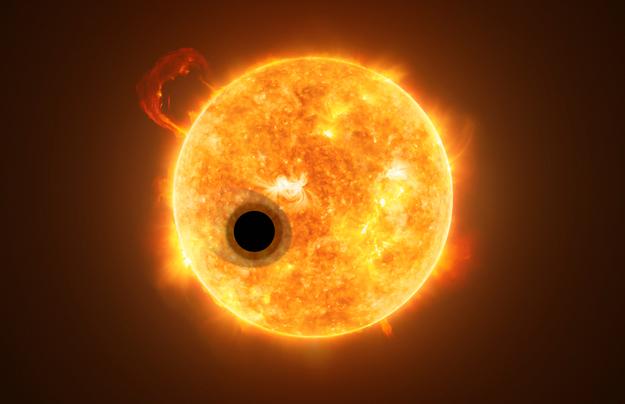A gaseous planet similar in size to Jupiter, but an extraterrestrial planet with a much smaller core mass has been found, attracting the attention of academics.
The mysterious planet’s identity, uncovered by Caroline Piaulet, PhD researcher at the University of Montreal’s Institute for Extraterrestrial Exploration (iREx), is the’WASP’ orbiting around the Virgo star WASP-107, about 212 light-years away from Earth. -107b’
The WASP-107b, first discovered in 2017, is located very close to the home star, which is 16 times closer than the distance between the Earth and the Sun. However, this planet is as big as Jupiter, but it is not dense enough to have a mass of 10 times less, so it was called the’cotton candy planet’ by genius physicists.

A gaseous planet similar in size to Jupiter, but an extraterrestrial planet with a much smaller core mass has been published. The picture is an imagination of the WASP-107b orbiting its home star. ⒸESA/Hubble, NASA, M. Kornmesser
Scientists from the United States, Germany, and Japan, including Piaolet, have used observations from the Keck Telescope, the largest telescope on the ground in Hawaii, to calculate the planet’s exact mass. The method they used to calculate the mass was the radial velocity method, which observed the shaking of the parent star due to the planet’s gravity.
As a result, the researchers found that the WASP-107b was about 1/10 the mass of Jupiter, or about 30 times Earth’s mass. Afterwards, the researchers analyzed the planet’s internal structure and discovered surprising facts. The mass of the central core that holds the planet’s gas is not more than four times the Earth.
This means that more than 85% of the planet’s mass is a thick layer of gas. In contrast, in the case of Neptune, which has a similar mass to the WASP-107b, the mass of the gas layer is only 5 to 15% of the total mass.
The core mass is only four times the Earth’s mass.
“This study deals with basic knowledge of how giant gas planets can form and grow,” said Dr. Björn Benneke, Phiolet’s supervisor. It turns out that it can have a large gas layer.”
The results of this study were published in the international journal’Astronomical Journal’ on January 18th.
Planets form from a disk of dust and gas that surrounds a young star, called a primitive planetary disk. In order to accumulate a large amount of gas before the disk dies, it must have a core that is at least ten times larger than Earth’s, as in the case of Jupiter and Saturn, the classic models of gas giant planets.
So how could the WASP-107b with a much smaller core nucleus be formed? Also, how could we prevent the planet’s enormous gas layer from escaping by gravity even though it was very close to the home star?
McGill University professor Eve Lee, a world-renowned expert on gas planets and a member of the Institute for Extrasolar Planetary Exploration (iREx), gave a hypothesis about this. At the time this planet was formed, the gas in the disk was cold enough to allow the gas to accumulate very quickly because it was far from the parent star. It is explained that the WASP-107b has since moved to its current position through interaction with the disk or other planets.
Discovery of a second planet hinting at a chaotic past
In fact, the researchers further discovered the second planet, WASP-107c, orbiting WASP-107. The planet is about a third of Jupiter’s mass, much larger than WASP-107b, and farther away from its parent star.
In the case of the WASP-107b, the orbiting period is only 5.7 days, while the planet takes three years. Also, the planet has a high eccentricity, so its orbit is not circular but elliptical.
Researcher Piaolet said, “The presence of the WASP-107c suggests a rather confusing past that has occurred in this star system, such as the sudden change in position of the WASP-107b.”

Caroline Piaolette, a researcher at the University of Montreal, Canada who led the study. ⒸUniversité de Montréal iREx
In addition to the malformed core, the WASP-107b contains another mystery to be solved. A study published in Nature in May 2018 found that the planet’s atmosphere was filled with helium gas.
Helium, one of the most commonly found components in the universe, has been thought to exist in the atmosphere of large planets. However, it is the first time WASP-107b has been found to exist in the atmosphere of extrasolar planets outside the solar system.
The problem is the fact that WASP-107b’s atmosphere contains little methane. This is very strange, as this kind of planet needs to be rich in methane. The researchers, including Piaolet, are analyzing which mechanism caused the destruction of methane on the planet, taking into account the newly discovered mass.
The researchers said they expect the James Webb space telescope, scheduled for launch this year, to provide more specific observations of the WASP-107b’s atmospheric composition.
(102)
